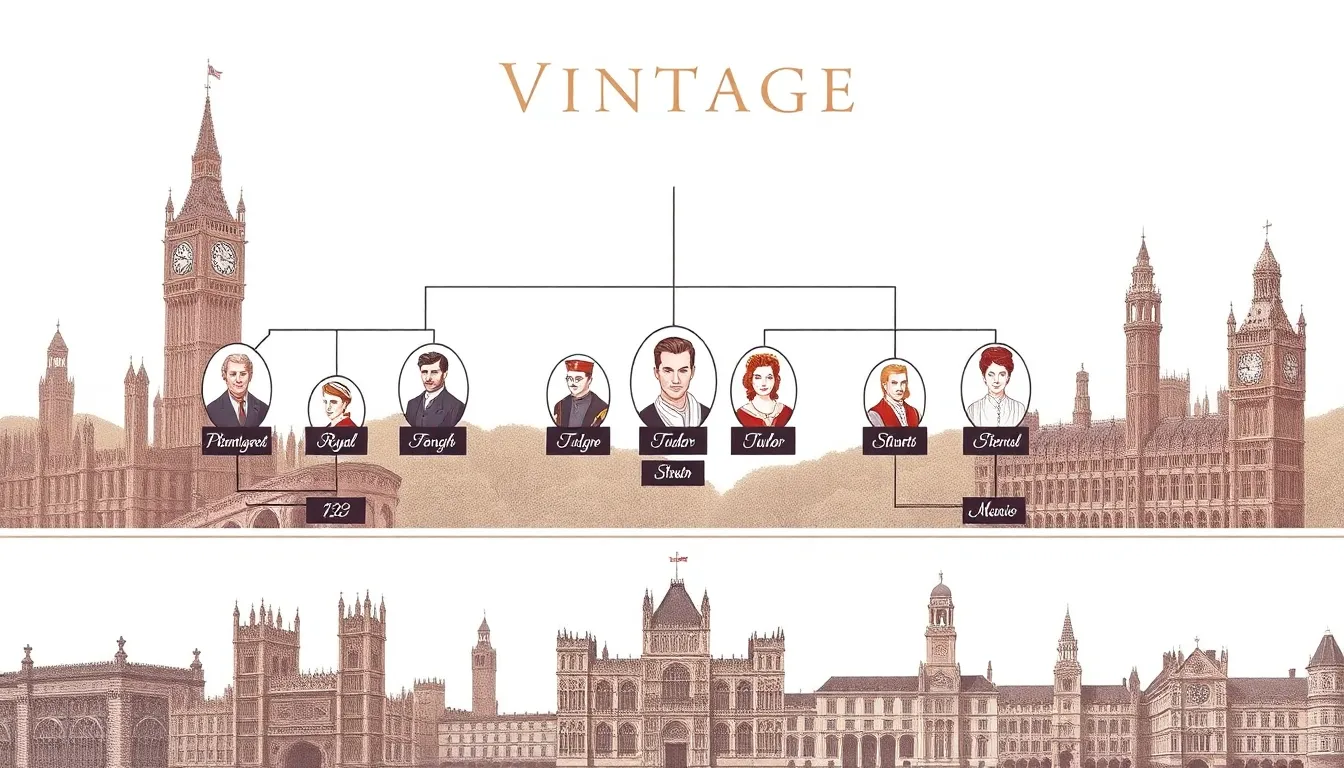Ever wondered what the royal family tree looked like before Queen Victoria took the throne? Picture a tangled web of kings, queens, and a few questionable hairstyles. It’s a captivating saga filled with power struggles, scandalous affairs, and enough drama to make a soap opera look tame.
Before Victoria’s reign, the British monarchy was anything but boring. From the Plantagenets to the Tudors, each branch of the family tree tells a story of ambition, rivalry, and a touch of madness. As they navigated through wars, marriages, and the occasional beheading, these royals shaped the course of history in ways that still resonate today. Join the journey through time and discover the fascinating characters who paved the way for the modern monarchy.
Table of Contents
ToggleOverview of the Royal Family Tree
The royal family tree before Queen Victoria showcases a lineage rich in history and intrigue. This lineage encompasses significant dynasties that shaped the course of British governance and culture.
Importance of the Royal Family Tree
The royal family tree serves as a record of lineage, highlighting connections among various monarchs. Understanding these connections illuminates the evolution of the monarchy. It explains the transition of power and the allegiances formed through marriage alliances. This lineage provides context for political decisions and conflicts experienced throughout British history. It illustrates how bloodlines influenced succession and the stability of the crown.
Key Historical Context
Key historical events shaped the royal family tree leading up to Queen Victoria’s reign. The Plantagenets ruled England from 1154 to 1485, known for internal conflicts and territorial expansion. The subsequent Tudor dynasty, ruling from 1485 to 1603, brought about significant changes, including the establishment of the Church of England. Notable figures like Henry VIII and Elizabeth I left a lasting legacy during this time. Political shifts, wars, and marriages forged crucial alliances among European royal families. These dynamics established a complex web of relationships that influenced future monarchs and the development of the nation.
Major Dynasties Before Queen Victoria

The British royal family tree features prominent dynasties that shaped its history well before Queen Victoria’s reign. Key figures from the Plantagenets to the Stuarts influenced governance and culture through power struggles and alliances.
The House of Tudor
The House of Tudor ruled from 1485 to 1603, starting with Henry VII. Henry established a firm monarchy after the Wars of the Roses, using marriage alliances to strengthen power. His son, Henry VIII, is noted for his six marriages and significant religious reforms. Elizabeth I, his daughter, ushered in a golden age of culture and exploration. The Tudors are renowned for their tumultuous politics and notable events, impacting England’s religious landscape and establishing the foundation for future monarchs.
The House of Stuart
Following the Tudors, the House of Stuart emerged, beginning with James I in 1603. His accession marked the union of the crowns of England and Scotland. The Stuart era faced challenges, including the English Civil War and the eventual execution of Charles I. Restoration under Charles II brought changes, including a renewed focus on arts and culture. This dynasty played a critical role in the transition toward constitutional monarchy and ongoing political dynamics, highlighting the complexities of royal authority and governance.
Notable Monarchs and Their Contributions
The royal family’s history showcases remarkable figures whose influences shaped British society. Each monarch brought unique contributions that resonated through generations.
Henry VIII’s Legacy
Henry VIII’s reign lasted from 1509 to 1547, marked by significant political and religious transformations. As a patron of the English Reformation, he established the Church of England, breaking away from papal authority. Marriages to six wives underscored his quest for a male heir, resulting in the dissolution of monasteries and redistribution of church wealth. His policies fortified royal power and centralized governance, laying a foundation for future monarchs. Innovations in foreign policy, including alliances through marriage, expanded England’s influence in Europe.
Elizabeth I and the Arts
Elizabeth I, ruling from 1558 to 1603, greatly enhanced England’s cultural landscape. Her patronage of the arts, especially theater, fostered a golden age marked by playwrights like William Shakespeare and Christopher Marlowe. During her reign, advancements in literature and exploration occurred, showcasing England’s growing power on the world stage. Diplomatic relations improved, particularly with Spain, solidifying England’s position in global politics. Vibrant cultural expressions flourished through fairs and festivals, enriching national identity and pride.
Significant Marriages and Alliances
Marriages within the royal family tree before Queen Victoria significantly impacted British history. These unions helped forge political relationships and consolidate power.
Marriages That Shaped the Monarchy
Marriages among the Plantagenets, Tudors, and Stuarts facilitated the strengthening of dynastic claims. For example, the marriage between Henry VII and Elizabeth of York united two rival houses, thereby ending the Wars of the Roses. Similarly, the union of Mary, Queen of Scots, with Francis II of France aimed to consolidate Scottish and French interests. This alliance, while ultimately flawed, demonstrated the importance of matrimonial connections in royal strategy. Each marriage not only symbolized unity but also strategically enhanced territories.
Political Alliances Through Weddings
Political alliances formed through royal weddings often changed the landscape of power in England. A notable case involved the marriage between James I and Anne of Denmark, enhancing ties between England and Scotland. Another pivotal alliance emerged with the wedding of Charles I and Henrietta Maria of France, which brought Catholic influence into a predominantly Protestant England. Marriages between royal families across Europe were crucial, fostering peace and ensuring heirs to the throne. Each wedding allowed monarchs to navigate complex political realities, ultimately shaping the future of the monarchy.
Influence on the Modern British Monarchy
The lineage of the British royal family before Queen Victoria deeply influences the monarchy today. This legacy shaped traditions, protocols, and the royal role in governance.
Continuation of Royal Lineage
Monarchs like Henry VII and Elizabeth I laid a foundation for the modern royal family tree. The marriage between Henry VII and Elizabeth of York unified rival factions, ending the Wars of the Roses. Royal marriages continued to intertwine dynastic lines across Europe, strengthening alliances. This network of connections expanded political influence. Additionally, the unification of the crowns under James I marked an important shift that paved the way for future governance. Each successor has drawn on this heritage, shaping their reign through historical narratives.
Lasting Impact on Future Generations
The decisions made by monarchs in earlier centuries echo in the current monarchy. Events like the English Civil War showcased the complexities of royal power. These struggles reflected the evolving relationship between the crown and Parliament. The cultural advancements during Elizabeth I’s rule set a standard for the arts and exploration that resonates today. Furthermore, marriages have continued to shape political alliances, ensuring the monarchy’s relevance. By understanding these historical connections, it becomes clear how past events remain integral to the identity of the modern British monarchy.
The royal family tree before Queen Victoria reveals a complex tapestry of power and intrigue. Each dynasty contributed to shaping not only the monarchy but also British society and governance. The legacies of the Plantagenets, Tudors, and Stuarts laid crucial foundations for the modern monarchy.
Through strategic marriages and political alliances, these monarchs navigated challenges that defined their reigns. Their stories of conflict, reform, and cultural flourishing echo through history, influencing the royal family’s identity today. Understanding this lineage enriches the appreciation of the monarchy’s evolution and its ongoing significance in contemporary Britain.


